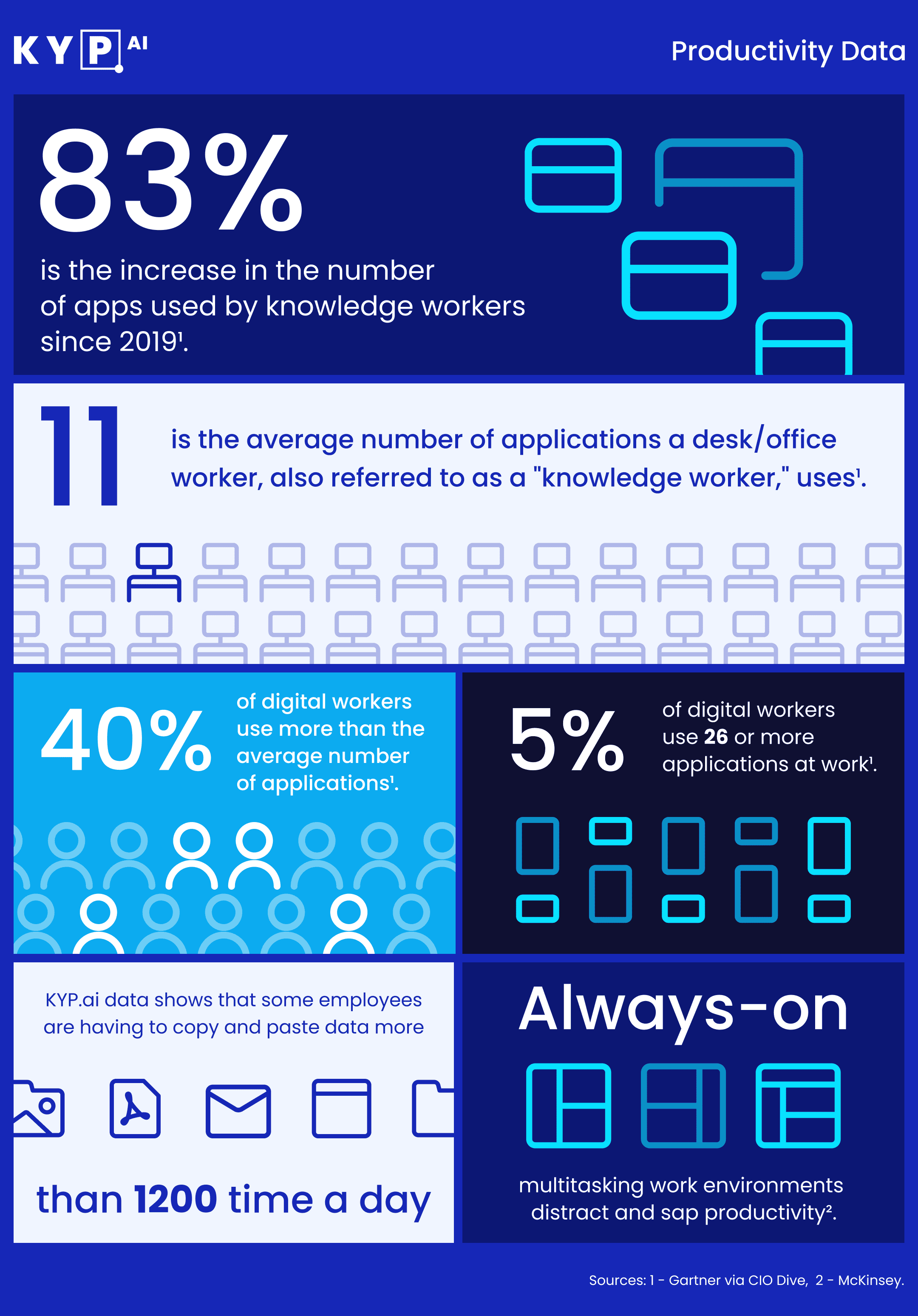A persistent productivity challenge in the digital age
In the year 2024, it’s astonishing that a significant portion of our workday is still consumed by the mundane task of copying and pasting data across various computer programs. This antiquated method of ‘swivel chair data integration’ not only detracts from employee focus but also incurs substantial costs for businesses, particularly when it involves highly skilled personnel. It is common for knowledge workers to find themselves trapped in a cycle of maintaining data across several platforms, and that severely impairs productivity. Fortunately, the advent of intelligent technologies like KYP.ai and AI-driven tools promises a way forward, offering innovative solutions to this pervasive issue.
The scale of the problem
Data from KYP.ai’s Productivity 360 platform shows the extent of the problem. Skilled professionals, for example, in IT support and specialized customer service roles, are having to constantly duplicate data. In one example, the effort of constantly juggling between applications was equivalent to three full-time employees per week dedicated to working only on such tasks.
In a second example, KYP.ai insights showed extensive copy and paste activity undertaken by members of a team. Each were having to cut and paste data between systems more than 1200 times a day. In another example, KYP.ai process intelligence showed that time equivalent to two FTEs in a team of 11 could be saved if the swivel chair integration was done by robots. That would significantly reduce the friction felt by the team.
In some cases employees had taken to extensive use of other software tools like Excel and Notes, largely to support copy and paste, instead of utilising the full features of their business applications. They spent more hours in maintaining these other applications than engaging with primary business software.
The long tail of secondary applications
The large number of applications in use in enterprises compounds the problem because often processes are fragmented with a long tail of secondary applications that are hardly ever used and yet require manual data entry to keep their information up to date. Employees have to spend a lot of time switching between these applications. Moreover, once they are working in an application more switching is required between its different forms and screens. All of this screen and context switching takes a toll on employee focus and productivity.
Data from Gartner shows the scale of the proliferation of applications. It estimates that there has been an 83% increase in the number of applications used by knowledge workers since 20191. According to the analyst firm there are 11 applications per employee on average. Furthermore, 40% of digital workers use more than the average number of applications and 5% use 26 or more at work.
According to McKinsey, always-on, multitasking work environments are so distracting that they are sapping productivity. Toggling between applications for copy and paste could take its toll on productivity. Add to the mix other interruptions, like correcting data entry errors that happen when the task is done manually, then the toll on productivity is certain to climb higher.
One way to solve this problem is to cut the long tail of secondary applications from processes by identifying and decommissioning those that are severely under-used. Process intelligence software like KYP.ai’s Productivity 360 provides the usage insights that allow organisation to make informed decisions about application consolidation. By reducing the number of applications per head you not only save on license costs but relieve staff from pointless manual data entry.

Intelligent solutions for improving productivity
Process intelligence can make these inefficiencies visible. It can provide a holistic view of issues too. By analyzing process workflows, technology use, and work patterns, critical bottlenecks can be identified to lead to actionable solutions. Whether it’s through the automation of data entry via RPA, streamlining application portfolios, or enhancing staff proficiency in underutilized application features, the insights aim to eradicate the need for manual data entry, freeing up valuable time and resources.
The solution lies in harnessing the power of process intelligence to detect and rectify these inefficiencies, thereby unlocking new levels of productivity and job satisfaction. From automating tedious tasks to optimizing application usage and improving workforce training, the potential for transformation is bigger than we imagine.
Embracing the future of work
The continuing swivel chair integration in the 21st century, against a backdrop of significant advances in technologies that eliminate the problem, is a clear indicator of the millions of dollars in productivity gains that organisations are leaving on the table. By accepting and addressing this challenge head-on, enterprises can tap new styles of augmented working by AI and other advanced technologies. They can not only conserve resources but also foster a more engaged and productive workforce.
We invite you to explore how embracing these intelligent solutions can revolutionize your work environment, making it more streamlined and efficient for everyone involved. There are 40 KYP.ai partners that help to automate and augment the swivel chair activities, which our platform recommends, measuring the business case upfront and validating the tangible impact upon deployment.
 Sarah Burnett
Sarah Burnett 